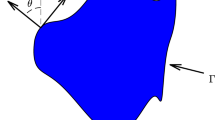Abstract
In this paper, we propose simple numerical algorithms for partial differential equations (PDEs) defined on closed, smooth surfaces (or curves). In particular, we consider PDEs that originate from variational principles defined on the surfaces; these include Laplace–Beltrami equations and surface wave equations. The approach is to systematically formulate extensions of the variational integrals and derive the Euler–Lagrange equations of the extended problem, including the boundary conditions that can be easily discretized on uniform Cartesian grids or adaptive meshes. In our approach, the surfaces are defined implicitly by the distance functions or by the closest point mapping. As such extensions are not unique, we investigate how a class of simple extensions can influence the resulting PDEs. In particular, we reduce the surface PDEs to model problems defined on a periodic strip and the corresponding boundary conditions and use classical Fourier and Laplace transform methods to study the well-posedness of the resulting problems. For elliptic and parabolic problems, our boundary closure mostly yields stable algorithms to solve nonlinear surface PDEs. For hyperbolic problems, the proposed boundary closure is unstable in general, but the instability can be easily controlled by either adding a higher-order regularization term or by periodically but infrequently “reinitializing” the computed solutions. Some numerical examples for each representative surface PDEs are presented.















Similar content being viewed by others
References
Ahmed, S., Bak, S., McLaughlin, J., Renzi, D.: A third order accurate fast marching method for the eikonal equation in two dimensions. SIAM J. Sci. Comput. 33(5), 2402–2420 (2011)
Barrett, J.W., Elliott, C.M.: A finite-element method for solving elliptic equations with Neumann data on a curved boundary using unfitted meshes. IMA J. Numer. Anal. 4, 309–325 (1984)
Bertalmıo, M., Cheng, L.-T., Osher, S., Sapiro, G.: Variational problems and partial differential equations on implicit surfaces. J. Comput. Phys. 174(2), 759–780 (2001)
Chambolle, A.: An algorithm for total variation minimization and applications. J. Math. Imaging Vis. 20(1–2), 89–97 (2004)
Cheng, L., Tsai, R.: Redistancing by flow of time dependent Eikonal equation. J. Comput. Phys. 227, 4002–4017 (2008)
Deckelnick, K., Elliott, C.M., Ranner, T.: Unfitted finite element methods using bulk meshes for surface partial differential equations. SIAM J. Numer. Anal. 52(4), 2137–2162 (2014)
Demlow, A.: Higher-order finite element methods and pointwise error estimates for elliptic problems on surfaces. SIAM J. Numer. Anal. 47(2), 805–827 (2009)
Demlow, A., Dziuk, G.: An adaptive finite element method for the Laplace–Beltrami operator on implicitly defined surfaces. SIAM J. Numer. Anal. 45(1), 421–442 (2007)
Dziuk, G.: Finite elements for the Beltrami operator on arbitrary surfaces. In: Partial Differential Equations and Calculus of Variations. Lecture Notes in Mathematics, vol. 1357, pp. 142–155. Springer, Berlin (1988)
Dziuk, G., Elliott, C.M.: Finite element methods for surface PDEs. Acta Numer. 22, 289–396 (2013)
Evans, L.C., Gariepy, R.F.: Measure Theory and Fine Properties of Functions. Studies in Advanced Mathematics. CRC Press, Boca Raton (1992)
Greer, J.B.: An improvement of a recent Eulerian method for solving PDEs on general geometries. J. Sci. Comput. 29(3), 321–352 (2006)
Gustafsson, B., Kreiss, H.-O., Oliger, J.: Time Dependent Problems and Difference Methods, vol. 24. Wiley, New York (1995)
Imbert-Gérard, L.-M., Greengard, L.: Pseudo-spectral methods for the Laplace–Beltrami equation and the Hodge decomposition on surfaces of genus one. Numer. Methods Part. Differ. Equ. 33(3), 941–955 (2017)
Jiang, G.-S., Peng, D.: Weighted ENO schemes for Hamilton–Jacobi equations. SIAM J. Sci. Comput. 21(6), 2126–2143 (2000)
Kreiss, H.-O., Petersson, N.A., Yström, J.: Difference approximations of the Neumann problem for the second order wave equation. SIAM J. Numer. Anal. 42(3), 1292–1323 (2004)
Kublik, C., Tanushev, N., Tsai, R.: An implicit interface boundary integral method for Poisson’s equation on arbitrary domains. J. Comput. Phys. 247, 279–311 (2013)
Kublik, C., Tsai, R.: Integration over curves and surfaces defined by the closest point mapping. Res. Math. Sci. 3(1), 3 (2016)
Macdonald, C.B., Ruuth, S.J.: The implicit closest point method for the numerical solution of partial differential equations on surfaces. SIAM J. Sci. Comput. 31(6), 4330–4350 (2009)
Marsden, J.E., West, M.: Discrete mechanics and variational integrators. Acta Numer. 10, 357–514 (2001)
Olshanskii, M., Safin, D.: A narrow-band unfitted finite element method for elliptic PDEs posed on surfaces. Math. Comput. 85(300), 1549–1570 (2016)
Olshanskii, M.A., Reusken, A.: A finite element method for surface PDEs: matrix properties. Numer. Math. 114(3), 491–520 (2010)
Olshanskii, M.A., Reusken, A., Grande, J.: A finite element method for elliptic equations on surfaces. SIAM J. Numer. Anal. 47(5), 3339–3358 (2009)
O’Neil, M.: Second-kind integral equations for the Laplace–Beltrami problem on surfaces in three dimensions. Adv. Comput. Math. (20018). https://doi.org/10.1007/s10444-018-9587-7
Osher, S., Fedkiw, R.: Level Set Methods and Dynamic Implicit Surfaces. Springer, Berlin (2000)
Osher, S., Sethian, J.A.: Fronts propagating with curvature dependent speed: algorithms based on Hamilton–Jacobi formulations. J. Comput. Phys. 79, 12–49 (1988)
Reuter, M., Wolter, F.-E., Peinecke, N.: Laplace–Beltrami spectra as ’Shape-DNA’ of surfaces and solids. Comput. Aided Des. 38(4), 342–366 (2006)
Rustamov, R.M.: Laplace–Beltrami eigenfunctions for deformation invariant shape representation. In: Proceedings of the Fifth Eurographics Symposium on Geometry Processing, pp. 225–233. Eurographics Association (2007)
Ruuth, S.J., Merriman, B.: A simple embedding method for solving partial differential equations on surfaces. J. Comput. Phys. 227(3), 1943–1961 (2008)
Sethian, J.A.: Fast marching methods. SIAM Rev. 41(2), 199–235 (1999)
Tsai, Y.-H.R.: Rapid and accurate computation of the distance function using grids. J. Comput. Phys. 178(1), 175–195 (2002)
van Daalen, E.F.G., Broeze, J., van Groesen, E.: Variational principles and conservation laws in the derivation of radiation boundary conditions for wave equations. Math. Comp. 58(197), 55–71 (1992)
Vogl, C. J.: The curvature-augmented closest point method with vesicle inextensibility application. J. Comput. Phys. 345, 818–833 (2017)
Xu, J.-J., Li, Z., Lowengrub, J., Zhao, H.: A level-set method for interfacial flows with surfactant. J. Comput. Phys. 212(2), 590–616 (2006)
Xu, J.-J., Yang, Y., Lowengrub, J.: A level-set continuum method for two-phase flows with insoluble surfactant. J. Comput. Phys. 231(17), 5897–5909 (2012)
Xu, J.-J., Zhao, H.-K.: An Eulerian formulation for solving partial differential equations along a moving interface. J. Sci. Comput. 19(1), 573–594 (2003)
Zhang, Y.-T., Zhao, H.-K., Qian, J.: High order fast sweeping methods for static Hamilton–Jacobi equations. J. Sci. Comput. 29(1), 25–56 (2006)
Acknowledgements
Tsai thanks the National Center for Theoretical Sciences, Taiwan, for support of his visits, during which this work was initiated and completed. Tsai was partially supported by NSF Grants DMS-1318975 and DMS-1620473. Chu was partially supported by MOST Grants 105-2115-M-007 -004 and 106-2115-M-007 -002.
Author information
Authors and Affiliations
Corresponding author
Additional information
Publisher’s Note
Springer Nature remains neutral with regard to jurisdictional claims in published maps and institutional affiliations.
Appendix
Appendix
1.1 Extension of surface gradient and surface divergence in \(\mathcal {\mathbb {R}}^{3}\)
Let \(\Omega \subset \mathbb {R}^{3}\) be a bounded open set with \(C^{2}\) boundary \(\Gamma =\partial \Omega \). For simplicity, we assume there exists a signed-distance function \(d_{\Gamma }:\mathbb {R}^{3}\rightarrow \mathbb {R}\) such that \(\Gamma \) is the zero-level set of \(d_{\Gamma }\). Without loss of generality, we also assume that \(d_{\Gamma }<0\) on the interior of \(\Gamma \) and \(d_{\Gamma }>0\) on the exterior. The normal vector \(\mathbf {n}(x)=\nabla d_{\Gamma }(x)\) is the unit outer normal vector field of \(\Gamma \) and the projection \(\Pi =I-\mathbf {n}\otimes \mathbf {n}\) which maps vectors in \(\mathbb {R}^{3}\) onto the tangent space of \(\Gamma \) at x. For any smooth function u defined on \(\Gamma \), the tangent gradient of u is defined by
where \(\tilde{{u}}\) is any \(C^{1}\) extension of u(x) in a neighborhood of x. For any smooth vector field F defined on \(\Gamma \), the surface divergence \(\nabla _{\Gamma }\cdot F\) is defined analogously. Recall that \(\eta \)-level set of \(d_{\Gamma }\) is \(\Gamma _{\eta }=\{x\in \mathbb {R}^{3}\,|\,d(x)=\eta \}\) and \(T_{\epsilon }=\cup _{|\eta |<\epsilon }\Gamma _{\eta }\) is the \(\epsilon -\)narrowband of \(\Gamma \). The following theorem relates constant-along-normal extension of the surface gradient and divergence to the Eulerian gradient and divergence of normal-extended function.
Theorem A.1
Suppose u is a smooth function defined on \(\Gamma \). Let \(P_{\Gamma }\) denote the closest point mapping and \(\overline{u}\) denote the constant-along-normal extension of u in \(T_{\epsilon }\). Then for any \(z\in T_{\epsilon }\), we have
where \(A(z;\mu )=A_{0}(z)+\mu A_{1}(z),\)
Here \(\mathbf {t}_{1}\), \(\mathbf {t}_{2}\) are the two orthonormal tangent vectors corresponding to the directions that yield the principle curvatures of \(\Gamma \), \(\mathbf {n}\) is the unit normal vector of \(\Gamma \), \(\sigma _{1}\) and \(\sigma _{2}\) are two largest singular values of \(DP_{\Gamma }\) and \(\mu \) is any real number.
Suppose F is a smooth vector field defined on \(\Gamma \). Let \(\overline{F}\) denote its constant-along-normal extension in \(T_{\epsilon }\). Then for any \(z\in T_{\epsilon }\) , we have
where \(B(z;\nu )=B_{0}(z)+\nu B_{1}(z),\)
where \(\nu \) is any real number. In particular, if we choose \(\nu =J\mu \), then \(B(z;\nu )=JA(z;\mu )\).
Proof
Let \((s_{1},s_{2})\) be a local coordinate system for \(\Gamma \) such that \(\mathbf {t}_{1}=\frac{{\partial \Gamma (s_{1,}s_{2})}}{\partial s_{1}}\) and \(\mathbf {t}_{2}=\frac{{\partial \Gamma (s_{1,}s_{2})}}{\partial s_{2}}\) are orthogonal unit eigenvectors of \(D^{2}d_{\Gamma }\) corresponding to two principle curvatures \(\kappa _{1}\) and \(\kappa _{2}\) respectively. Notice that \((s_{1},s_{2},\eta )\) forms curvilinear coordinates on \(T_{\epsilon }\) with the coordinate transformation
where \(\mathbf {n}(s_{1,}s_{2})=\mathbf {n}(\Gamma (s_{1,}s_{2}))\). By using \(\frac{\partial \mathbf {n}}{\partial s_{i}}=\kappa _{i}\mathbf {t}_{i}\), we obtain \(\frac{\partial z}{\partial s_{1}}=(1+\eta \kappa _{1}(s_{1,}s_{2}))\mathbf {t}_{1}\), \(\frac{\partial z}{\partial s_{2}}=(1+\eta \kappa _{2}(s_{1,}s_{2}))\mathbf {t_{2}}\) and \(\frac{\partial z}{\partial \eta }=\mathbf {n}\). By formula of gradient in orthogonal curvilinear coordinate systems, we have
It follows the tangential gradient of u is
By using the fact \((1+d(z)\kappa _{i}(P_{\Gamma }z))=(1-d(z)\kappa _{i}(z))^{-1}=\sigma _{i}\) and \(\mathbf {n}\cdot \nabla v=0\), we prove (A.1).
First notice that \(\mathbf {n}\cdot \overline{F}=0\) since \(\overline{F}\) is the normal extension of F. Let \(F^{1}\) and \(F^{2}\) denote the components of F in \(\mathbf {t_{1},}\mathbf {t_{2}}\) respectively. That is, \(F(x)=F^{1}(x)\mathbf {t_{1}}+F^{2}(x)\mathbf {t_{2}}\) for \(x\in \Gamma \). By formula of divergence in orthogonal curvilinear coordinate systems, we have
Therefore it follows
By \(\mathbf {n}\cdot \overline{F}=0\) , we have \(B_{1}(z;\nu )\overline{F}=0\). This shows (A.2) holds.
Remark
In fact, by using \(\mathbf {n}\cdot \overline{F}=0\) and \(\frac{\partial \overline{F^{1}}}{\partial \eta }\text {=}\frac{\partial \overline{F^{2}}}{\partial \eta }=0\), we can choose more general \(B_{1}\) as following
where \(\nu _{i}\) are arbitrary real numbers.
Remark
If \(\Gamma \) is a curve in \(\mathbb {R}^{2},\) then it can be shown analogously that
and
1.2 Second-order finite difference approximation for normal extension of surface Laplacian
In this paper, all numerical experiments are done by second-order finite difference schemes. We present the detail about finite difference scheme to approximate the normal extension of surface Laplacian \(\Delta _{\Gamma }u\). For simplicity, we demonstrate two- dimensional case and assume that \(\Delta x=\Delta y=h\), but it can be easily generalized to higher-dimensional cases with nonuniform Cartesian grids. Recall that the normal extended equation for surface Laplacian is given by
where \(A=\sigma ^{-1}\mathbf{t }\otimes \mathbf{t }+\mu {\mathbf{n }\otimes }{\mathbf{n }}=\left[ \begin{array}{cc} A^{11} &{}\quad A^{12}\\ A^{21} &{}\quad A^{22} \end{array}\right] \). We use central difference to approximate all terms as following
If \(v_{l,k}\) is taking value at a ghost node, replace \(v_{l,k}\) by linear combination of other \(v_{i,j}\) at inner nodes as discussed in Sect. 2.4.
Rights and permissions
About this article
Cite this article
Chu, J., Tsai, R. Volumetric variational principles for a class of partial differential equations defined on surfaces and curves. Res Math Sci 5, 19 (2018). https://doi.org/10.1007/s40687-018-0137-1
Received:
Accepted:
Published:
DOI: https://doi.org/10.1007/s40687-018-0137-1




